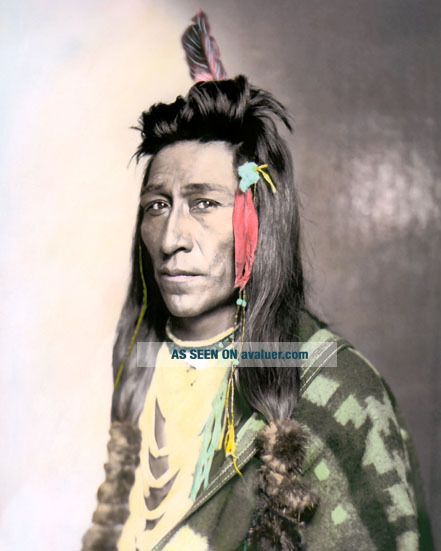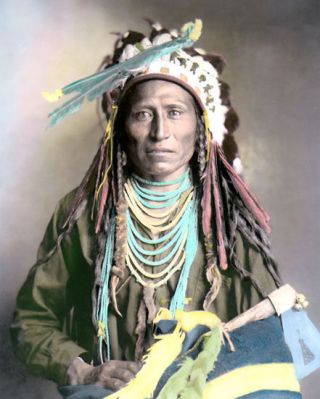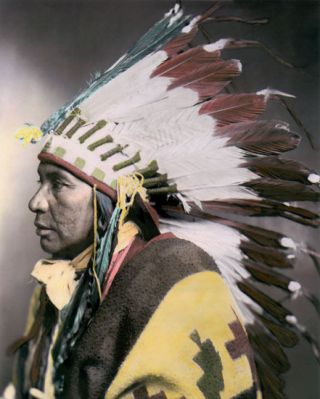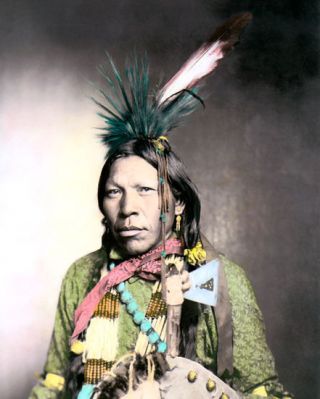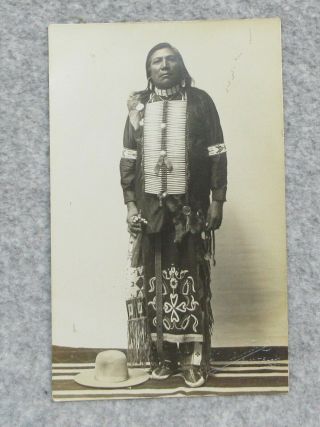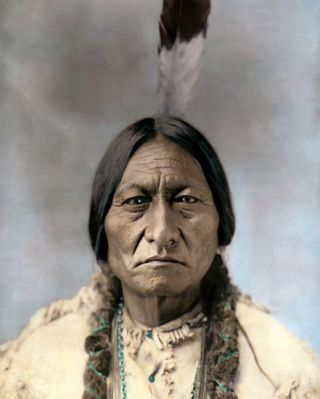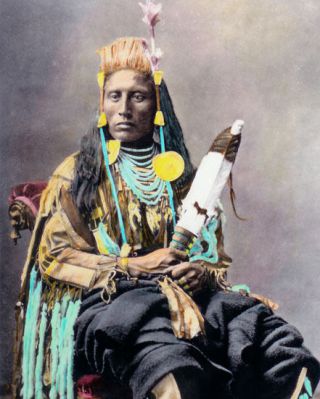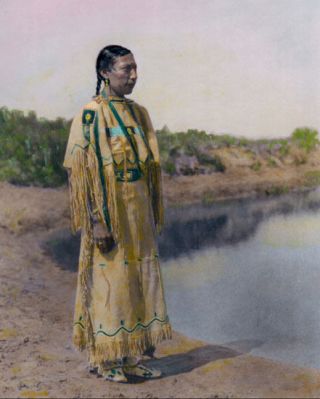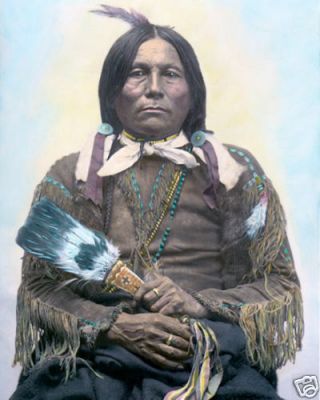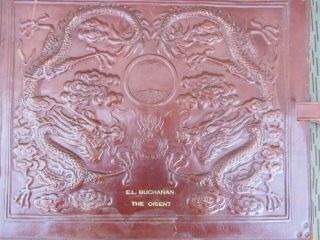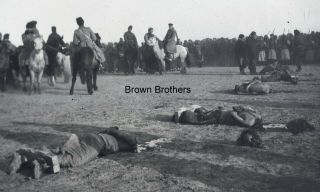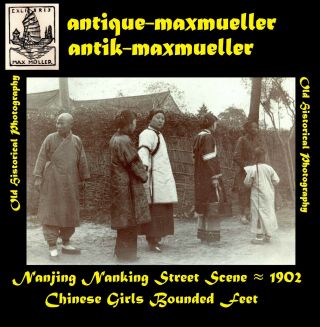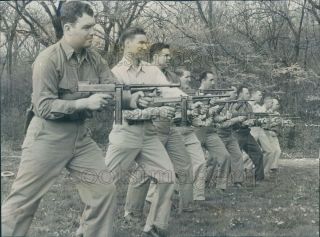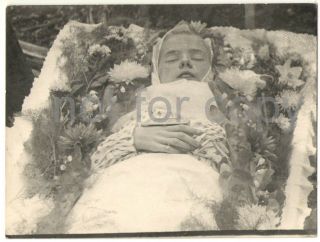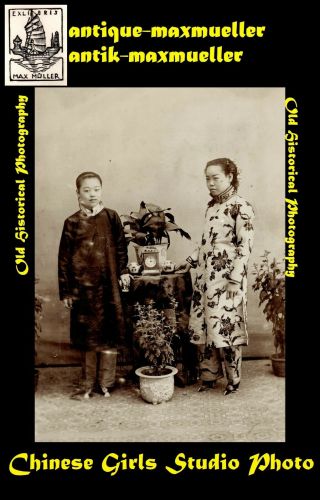MEASAW SHOSHONE NATIVE AMERICAN INDIAN 1899 8x10 " HAND COLOR TINTED PHOTOGRAPH
Item History & Price
This is a high-resolution (320 dpi/ 2, 560 x 3, 200 pixel) 8" x 10" vintage image, hand oil tinted and photo processed onto Fuji Film Archival Photo Paper. Fuji Film Archival Photo Paper is the highest quality paper and photo processing available. Fuji guarantees it not to fade for up to 70 years!
Measaw, Shoshon...e Native American 1899 The Shoshone or Shoshoni are a Native American tribe in the United States with three large divisions: the Northern, the Western and the Eastern.
They traditionally spoke the Shoshoni language, a part of the Numic languages branch of the large Uto-Aztecan language family. The Shoshone were sometimes called the Snake Indians by early ethnic European trappers, travelers, and settlers.
The Northern Shoshone are concentrated in eastern Idaho, western Wyoming, and northeastern Utah. The Northern Shoshone would live in teepees, ride horses, and hunt buffalo.
The Eastern Shoshone tribes lived in Wyoming, northern Colorado and Montana. After 1750, warfare and pressure from the Blackfoot, Crow, Lakota, Cheyenne, and Arapaho pushed them south and westward. Some of them moved as far south as Texas, to become the Comanche.
The Western Shoshone tribes lived in Oregon and western Idaho, and ranged from central Idaho, northwestern Utah, central Nevada. Some are also located in California. The Idaho groups of Western Shoshone were called Tukuaduka (sheep eaters), while the Nevada/Utah bands were called the Gosiute or Toi Ticutta (cattail eaters). In California the Timbisha Shoshone (also known as the Death Valley or Panamint Shoshone) have lived for centuries in the Death Valley, Saline Valley, Panamint Valley and surrounding mountains. They have a federally recognized tribal reservation and government at Furnace Creek, California. Shoshone-Paiute have continued to live in the Owens Valley. The Western Shoshone would live in roofless grass huts, hunt birds, fish and rabbits.
The most historically well-known member of the Shoshone tribe may be Sacagawea, of the Lemhi Shoshone band of Northern Shoshone. She accompanied the Corps of Discovery (Lewis and Clark Expedition) with Meriwether Lewis and William Clark in their exploration of the Western United States.
The Shoshone arose out of various cultures of indigenous peoples who had been in the territory for thousands of years. The Shoshone language is one of the Uto-Aztecan languages spoken by numerous peoples ranging from the Great Basin to coastal Southern California in present-day United States, and down through central, western and southern Mexico; into Central America and South America.
As more European-American settlers migrated west, tensions rose with the indigenous people. There were wars throughout the second half of the 19th century. The Northern Shoshone, led by Chief Pocatello, fought during the 1860s with settlers in Idaho (where a city was named for him). As more settlers encroached on Shoshone hunting territory, the natives raided farms and ranches for food, and attacked migrants. The warfare resulted in the Bear River Massacre (1863), when US forces trapped and murdered an estimated 350–500 Northwestern Shoshone, including women and children, who were at their winter encampment. This was the highest number of deaths which the Shoshone suffered by the forces of the United States. Allied with the Bannock, to whom they were related, the Shoshone fought against the United States in the Snake War from 1864–1868. They fought US forces together in 1878 in the Bannock War. In 1876, by contrast, the Shoshone fought alongside the U.S. Army in the Battle of the Rosebud, as it was against their traditional enemies, the Lakota and Cheyenne.
In 1879 a band of approximately 300 Western Shoshones (known as "Sheepeaters") was involved in the Sheepeater Indian War. It was the last Indian war fought in the Pacific Northwest region of the present-day United States.
In 1911 a small group of Bannock under a leader named "Shoshone Mike" killed four ranchers in Washoe County, Nevada. The settlers formed a posse and went out after the Native Americans. They caught up with the band on February 26, 1911 and killed eight. They lost one man of the posse, Ed Hogle. The posse captured three children and a woman. The partial remains of three adult males, two adult females, two adolescent males, and three children, believed to be Shoshone Mike and his family, according to contemporary accounts, were donated by a rancher to the Smithsonian Institution for study. In 1994, the institution repatriated the remains to the Fort Hall Idaho Shoshone-Bannock Tribe.
In 2008, the Northwestern Shoshone acquired the site of the Bear River Massacre and some surrounding land. They wanted to protect the holy land and build a memorial to the massacre, the largest their nation had suffered. "In partnership with the American West Heritage Center and state leaders in Idaho and Utah, the tribe has developed public/private partnerships to advance tribal cultural preservation and economic development goals." They have become a leader in developing tribal renewable energy.
Historic population
In 1845 the estimated population of Northern and Western Shoshone was 4, 500, much reduced after they had suffered infectious disease epidemics and warfare. The completion of the First Transcontinental Railroad in 1869 was followed by Euro-American immigrants arriving in unprecedented numbers in the territory.
In 1937 the Bureau of Indian Affairs counted 3, 650 Northern Shoshone and 1, 201 Western Shoshone. As of the 2000 census, there were 12, 000 Shoshone.
Photograph taken in the Wind River Valley 1899 & Hand Oil Tinted by artist Margaret A. Rogers You can't get this colorized version of this photo anywhere else!I have the exclusive rights to the sales of this image.Photographs are also available in larger sizes from 8x12" to 11x14", 12x16", 12x18", 16x20", 20x26" & 20x30".
Email me for a price quote. I'd be happy to create an auction just for you. FREE Shipping to anywhere in the United States Thank you for viewing my auction. Please check out my other photos!Good luck with your bidding. ( Vintage Photos, My Vintage Photos, MyVintagePhotos, Photographs )



